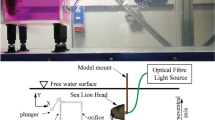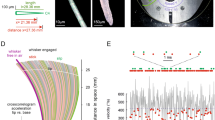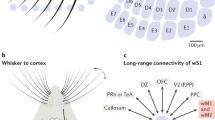Abstract
Whiskers mimicking those of seals or rats might be useful for underwater tracking or tactile exploration.
Several species of terrestrial and marine mammals with whiskers (vibrissae) use them to sense and navigate in their environment — for example, rats use their whiskers to discern the features of objects1, and seals rely on theirs to track the hydrodynamic trails of their prey2. Here we show that the bending moment — sometimes referred to as torque — at the whisker base can be used to generate three-dimensional spatial representations of the environment, and we use this principle to construct robotic whisker arrays that extract precise information about object shape and fluid flow. Our results will contribute to the development of versatile tactile-sensing systems for robotic applications, and demonstrate the value of hardware models in understanding how sensing mechanisms and movement control strategies are interlocked.
Similar content being viewed by others
Main
Rats actively whisk (rotate) their whiskers against objects during exploration1, whereas seals keep their whiskers relatively fixed in order to track fluid wakes2. Using classical elasticity theory3,4, we modelled the rat whisker as a conical beam bending against an object, and derived a monotonic relationship between the radial contact distance, d, and rate of change of moment, M, at the whisker base (see supplementary information). This theoretical solution was experimentally verified by using a strain gauge to measure moment at the base of a rat's plucked whisker as it was smoothly rotated against a slender peg placed at various radial distances (Fig. 1a). Agreement was excellent between the actual radial distance and that obtained from the experiment (for details, see supplementary information).
a, A whisker (red) of length L rotates through an angle θ against an object at distance d, which elicits a moment M at the base. b, Extraction of information about an object shape using an artificial whisker array (whisker lengths are 2, 3, 4 and 5 cm). c, Fluid-flow profiles, determined using two opposing whisker arrays, arranged as shown in the inset. V is the fluid velocity and each whisker is 0.5 cm×11 cm. Blue curve: data from whisker array; red: data from a Pitot tube placed at the height of each whisker, which gives the true air speed. Standard deviations (10 trials) are within the size of the symbols.
To investigate the shape-extraction capability of this encoding mechanism, we constructed a 4×1 array of robotic whiskers. Each spring-steel wire whisker was fitted with four strain gauges at its base to measure the two orthogonal components of moment. We tested the array by whisking it across a small, sculpted head, an object selected specifically for its intricate concavities and convexities (for details and video, see supplementary information). Whisking was performed with the array at evenly spaced heights and angles. Analysis of moments on each whisk provided four radial contact points in three-dimensional space (one for each whisker). Fitting a smooth surface to the contact points then resulted in a faithful extraction of the original shape of the sculpture (Fig. 1b).
To test the ability of whiskers to extract the features of fluid flows, we used two opposing 4×1 whisker arrays (Fig. 1c, inset). Each stainless steel wire was replaced with a thin, flexible, plastic strip to ensure that there was a large surface area normal to the flow and to maximize bending. When a stream of air moving at velocity V was directed towards the centre of the array, each whisker was deflected by a magnitude that was dependent on its distributed load, permitting an accurate characterization of the shape of the fluid stream (Fig. 1c). More complex whisker configurations would allow flow patterns to be described in three dimensions, which might enable moving underwater objects to be tracked by wake.
Until now, neural responses of the whisker system have been described mainly in terms of kinematic variables, that is, position and its variation with time. Our findings indicate that the primary sensory neurons of animals that use their whiskers for exploration may also encode information about moment. This idea is consistent with physiological recordings from the rat trigeminal ganglion5. Sensing moment at the whisker base during contact with an object could be a low-frequency counterpart to the whisker vibrations that are thought to be used to discriminate textures6,7.
Our results on biomimetically engineered whiskers may find application in land-based robots and autonomous underwater vehicles, in which a capability for tactile perception could broaden and enhance performance.
References
Krupa, D. J., Matell, M. S., Brisben, A. J., Oliveira, L. M. & Nicolelis, M. A. L. J. Neurosci. 21, 5752–5763 (2001).
Dehnhardt, G., Mauck, B. & Bleckmann, H. Nature 394, 235–236 (1998).
Kaneko, M., Kanayama, N. & Tsuji, T. IEEE Trans. Robotic. Autom. 14, 278–291 (1998).
Clements, T. N. & Rahn, C. D. IEEE Trans. Robotic. 22, 844–848 (2006).
Szwed, M. et al. J. Neurophysiol. 95, 791–802 (2006).
Neimark, M. A., Andermann, M. L., Hopfield, J. J. & Moore, C. I. J. Neurosci. 23, 6499–6509 (2003).
Hartmann, M. J., Johnson, N. J., Towal, R. B. & Assad, C. J. Neurosci. 23, 6510–6519 (2003).
Author information
Authors and Affiliations
Ethics declarations
Competing interests
The authors declare no competing financial interests.
Supplementary information
Supplementary information
Calculations and figures (PDF 1526 kb)
Rights and permissions
About this article
Cite this article
Solomon, J., Hartmann, M. Robotic whiskers used to sense features. Nature 443, 525 (2006). https://doi.org/10.1038/443525a
Received:
Accepted:
Published:
Issue Date:
DOI: https://doi.org/10.1038/443525a
This article is cited by
-
A nanonewton-scale biomimetic mechanosensor
Microsystems & Nanoengineering (2023)
-
Tactile perception: a biomimetic whisker-based method for clinical gastrointestinal diseases screening
npj Robotics (2023)
-
Seal and Sea lion Whiskers Detect Slips of Vortices Similar as Rats Sense Textures
Scientific Reports (2019)
-
On neuromechanical approaches for the study of biological and robotic grasp and manipulation
Journal of NeuroEngineering and Rehabilitation (2017)
-
What is the biological basis of sensorimotor integration?
Biological Cybernetics (2011)
Comments
By submitting a comment you agree to abide by our Terms and Community Guidelines. If you find something abusive or that does not comply with our terms or guidelines please flag it as inappropriate.




